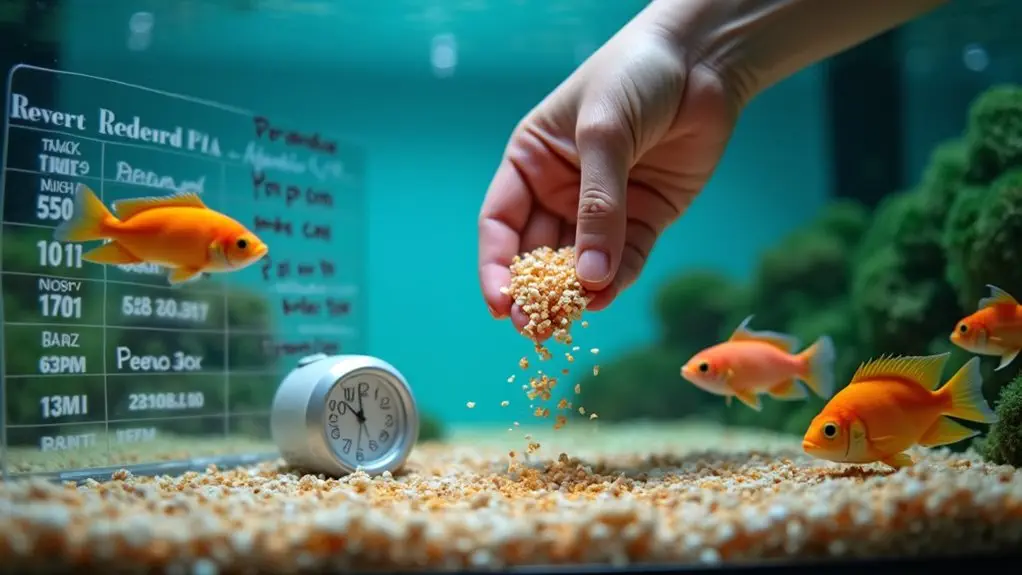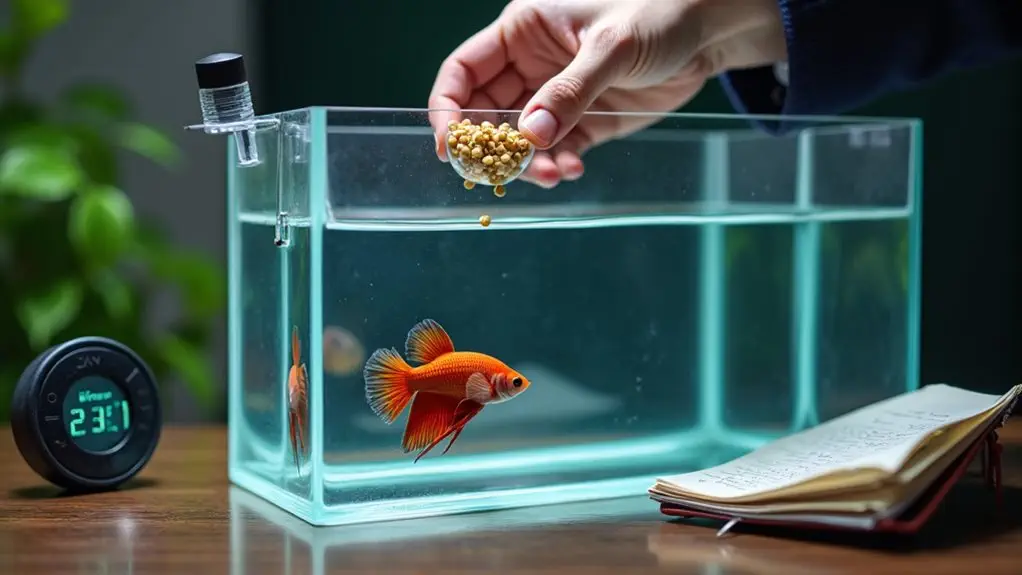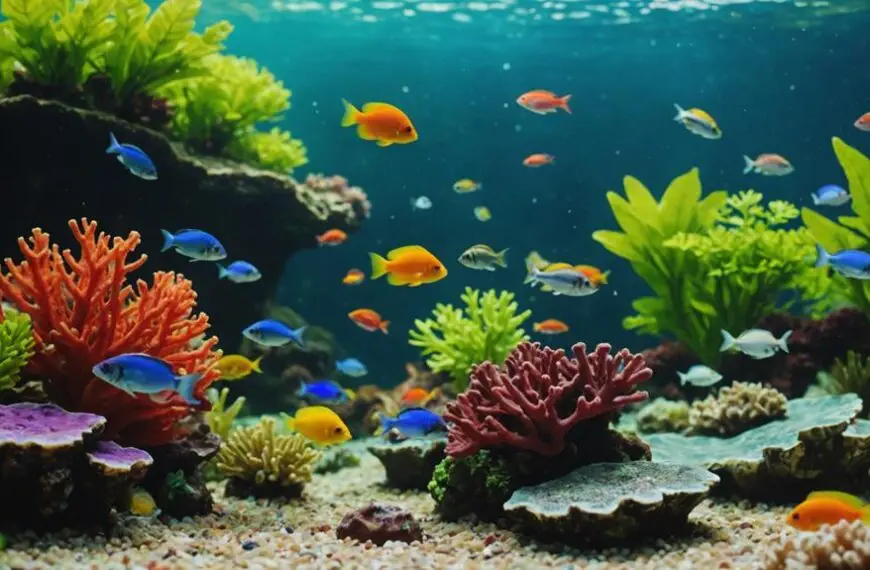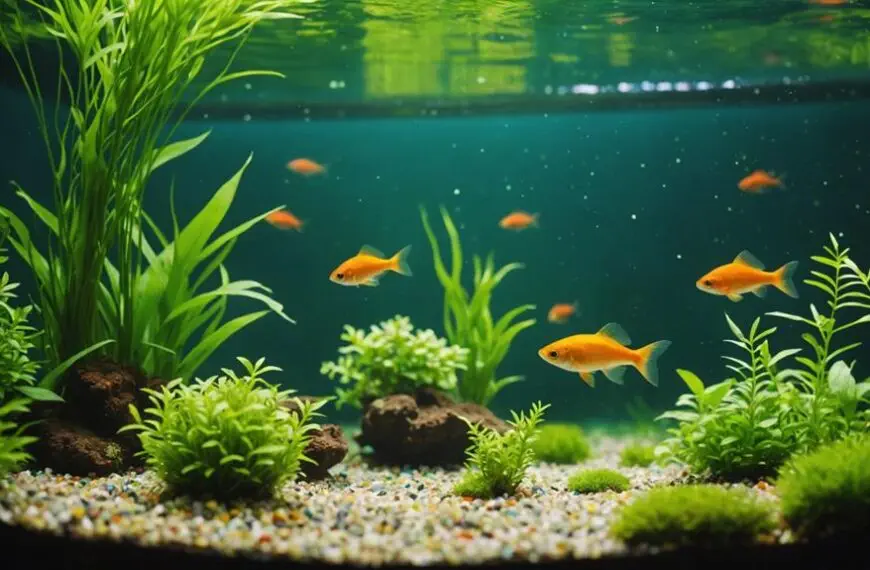To maintain healthy fish, feed most tropical species once or twice daily, offering only what they'll consume in 2-3 minutes. Match food types to their dietary needs—whether herbivore, carnivore, or omnivore—and rotate between quality flakes, pellets, and frozen options. Establish a consistent feeding schedule, as fish thrive on routine. Always monitor their behavior during mealtimes; enthusiastic swimming indicates good health. The right feeding approach will transform your aquarium into a vibrant underwater paradise.
Contents
- 1 Determine the Right Feeding Frequency for Your Fish Species
- 2 Measure Portion Sizes Appropriate for Your Tank Population
- 3 Select Quality Foods That Match Your Fish's Dietary Requirements
- 4 Establish a Consistent Feeding Routine and Stick to It
- 5 Monitor Your Fish's Health and Adjust Your Schedule as Needed
- 6 Frequently Asked Questions
- 7 Final Thoughts
Determine the Right Feeding Frequency for Your Fish Species

When should you feed your aquatic pets? It depends entirely on their natural feeding behavior and species differences. Most tropical fish do well with once or twice daily feedings, while goldfish might need only 3-4 meals per week due to their slower metabolism.
Watch your fish closely! Bettas get excited at feeding time, darting to the surface with those gorgeous fins fluttering. Meanwhile, bottom-dwellers like catfish prefer to forage throughout the day. You'll get to know your fishy friends' unique personalities! Additionally, be mindful of feeding routines that vary by species and ensure proper nutrition for a healthy aquarium.
Don't fall for those sad fish eyes begging for more food—they're quite the little actors! Overfeeding is actually the number one mistake new aquarists make.
Measure Portion Sizes Appropriate for Your Tank Population
Three simple rules govern proper fish portion sizing for ideal tank health.
First, feed only what your fish can consume in 2-3 minutes. You'll know you're overfeeding if food sinks to the bottom uneaten.
Watch your fish behavior during feeding—darting excitedly is normal, but frenzied competition might indicate insufficient portions.
Consider these factors when determining portion sizes:
- Tank size directly impacts how much waste your system can process
- Adult fish need proportionally less food than growing juveniles
- Species-specific needs vary dramatically (herbivores vs. carnivores)
- Seasonal temperature changes affect metabolism and appetite
- Population density increases competition for food
Additionally, maintaining optimal water parameters is crucial, as it can directly influence your fish's appetite and overall health.
Select Quality Foods That Match Your Fish's Dietary Requirements

Selecting the right food for your fish is just as essential as measuring proper portions for maintaining ideal health. Understanding fish nutrition basics helps you make informed decisions about what goes into your tank.
Different species have unique dietary needs—herbivores, carnivores, and omnivores all require specific nutrients to thrive.
Fish crave what their nature demands—herbivores, carnivores, and omnivores each need tailored nutrition to flourish in your aquarium.
Pay attention to your fish's food texture preferences, too. Some species love crunchy pellets, while others prefer soft flakes that quickly dissolve. You'll notice your fish showing excitement for certain foods—that's their way of telling you what works!
Don't forget to rotate between freeze-dried, frozen, and fresh options to provide a well-rounded diet. Your finned friends will reward your thoughtful food selection with vibrant colors, active behavior, and fewer health problems. Additionally, ensuring a diverse diet with high-quality flakes and pellets can greatly enhance their overall well-being.
Establish a Consistent Feeding Routine and Stick to It
Once you've selected the right foods for your aquatic pets, establishing a consistent feeding routine becomes your next essential step for their overall wellbeing.
Fish thrive on predictability, and their feeding behavior adapts to when they expect meals. You'll notice your finned friends becoming more active and responsive when they recognize it's mealtime!
- Feed at the same times each day (once or twice is ideal for most species)
- Provide only what they can consume in 2-3 minutes
- Watch for changes in routine consistency during seasonal shifts
- Consider using automatic feeders when you're away to maintain schedules
- Monitor your fish's response to the feeding routine and adjust as needed
Monitor Your Fish's Health and Adjust Your Schedule as Needed

While maintaining a consistent feeding routine forms the backbone of fish care, regular health monitoring takes your aquarium management to the next level.
Watch for changes in fish behavior during mealtimes—it's often your first clue something's amiss. Are your normally voracious tetras suddenly disinterested in food? That's a red flag.
Mealtime behavior speaks volumes—when fish refuse food, your aquarium is trying to tell you something important.
Make feeding observations part of your daily ritual. Notice how each fish responds when you approach the tank. Healthy fish typically swim enthusiastically toward food, while sick ones may hide or ignore meals entirely.
If you spot concerning patterns, don't hesitate to adjust your feeding schedule. Sometimes reducing portion sizes or switching to a different food type can make all the difference. Additionally, be cautious of overfeeding practices that can lead to increased waste and poor water quality.
Frequently Asked Questions
Can I Leave My Fish Unfed During Weekend Trips?
Yes, you can leave your fish unfed for a weekend trip. Most fish can adjust their behavior to survive without food for 2-3 days. Longer feeding duration gaps might cause stress though, so plan accordingly.
How Do I Prevent Other Pets From Eating Fish Food?
Out of sight, out of mind! Keep your fish food storage in a secure cabinet or high shelf where curious pets can't reach it. Always maintain pet supervision during feeding time to prevent unwanted snacking.
Should Feeding Schedules Change With the Seasons?
Yes, you should make seasonal adjustments to your feeding schedule. Fish metabolism slows in cooler temperatures, requiring less food, while warmer seasons increase their activity and hunger. Modify portions accordingly for ideal health.
Can I Use Automatic Feeders for Vacation Feeding?
Yes, you can use automatic feeders while you're away. They offer reliability and portion control benefits. Just test your automatic feeder before vacation, set appropriate portions, and have someone check occasionally for peace of mind.
How Do Different Water Temperatures Affect Fish Digestion?
Your fish's digestion rates slow down in colder water and speed up in warmer temperatures. You'll need to adjust feeding accordingly – less food in cold water, more when it's warm. Temperature impact is significant.
Final Thoughts
By following these five simple steps, you'll transform your fish feeding from guesswork to goldfish glory! Remember, your finned friends rely on you for their nutritional needs. Create a schedule that works for both of you, adjust when necessary, and you'll enjoy healthier, more vibrant fish. Watch them thrive under your care—it's an underwater ballet that's worth getting right!












